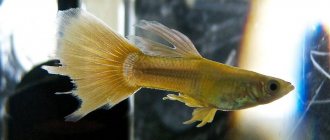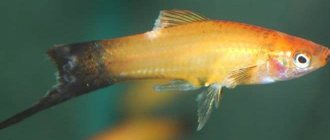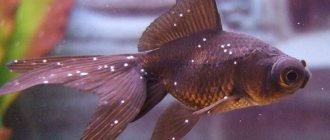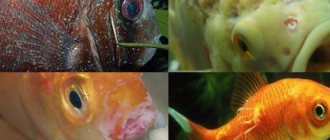Fin rot in fish is a fairly common disease. If no measures are taken to eliminate rot, this will lead to the death of the fish. If such a disease occurs in a young fish, a fry, then there is practically no chance of curing the fish; an adult fish has a stronger immune system and it is possible to cure it. The sooner you take action for treatment, the easier it will be to cure your fish. Fin rot of aquarium fish, symptoms, photos, treatment is what you will learn from this article.
Most often, fish with large fins and folds are susceptible to fin rot. Namely fish:
- angelfish
- cockerel
- neon
- guppy
- mollies
- barb
- veiltail
Fish with short fins can also be affected by the disease, but this happens in very rare cases. Not always after an illness, fish can restore their fins to the same form as they were before the illness. They become much shorter and the edge of the fin is not even. If fin rot is completely advanced and ulcers appear on the body of the fish, then it is useless to treat such fish.
Why do pets get sick?
Pseudomonosis occurs for various reasons.
The first of them is severe stress. The fish experience discomfort due to overcrowding of the aquarium, incompatibility with neighbors, and sudden changes in living conditions. The second reason is neglect of sanitation in the aquarium. It's no secret that bacteria spread very actively. If you neglect cleaning the fish's home - cleaning the bottom, soil, replacing part of the water - then pseudomonosis will not take long to occur.
The third reason is failure to comply with the necessary conditions of detention. Fish living in warm water (guppies, platies) require a temperature of 23-25 degrees. When temperatures drop, fish are at risk. An equally important point is aeration, filtration, replacement of part of the water and monitoring its condition.
Often the appearance of fin rot occurs as a result of non-compliance with sanitary conditions in pet stores. Therefore, a new fish or decorative item must be visually assessed and treated at home for infections.
Aquarium treatment
If fin rot is detected in the fish, the tank is completely emptied, including soil, decor, and special equipment. All contents are washed with warm and then hot water, dried with paper towels. The aquarium is thoroughly washed, but without using soap, and disinfected with a chloramine solution. The water is completely replaced. The ideal temperature is 26-28 degrees. You should definitely check it for the presence of nitrates, nitrites, and pH levels. You can add a few drops of tea tree. We strongly recommend seeking professional help to start up your aquarium after illness. This guarantees no relapse.
Interesting! Tea tree oil is not inferior to medical drugs in its antibacterial properties. It is used to get rid of wounds and swelling, to destroy fungus, mold, and unpleasant odors. It kills insect poison and helps in the fight against moths and garden pests.
Causes
Every aquarium has bacteria that cause fin rot and this is normal. They pose no threat to fish if their immunity can resist them. But these bacteria can attack if the fish’s immunity is weakened due to unfavorable conditions, and these are the conditions that are good for the proliferation of these bacteria.
If the causative agent of fin rot begins to develop rapidly, then without taking measures, the fish itself will not cope and will die.
Fin rot can occur due to:
- the fish has received severe stress or constant stress
- There are rotting plants in the aquarium
- water temperature below normal
- water temperature is above normal
- improper care of the aquarium, not timely replacements, bottom siphoning.
- incompatible fish in the aquarium - if the fish are aggressive and damage their fins, then through such a wound the bacteria can easily enter the body
- improper feeding of pets - a lack of necessary substances in the body leads to a weakening of the fish and a decline in its immunity.
Before buying, you should carefully examine the fish and inspect the fins. If the fins are destroyed, then it is not advisable to buy such fish. Since when moving fish and launching it to a new place, the fish is stressed and at this moment the pathogens of fin rot can attack the body of the weakened fish.
Disinfecting the aquarium to prevent a re-outbreak of the disease
Cleaning the aquarium of bacteria is very desirable for a truly effective and sustainable treatment result.
To disinfect, remove decorations made of plastic and artificial materials from the aquarium, clean and adjust the filters. Rinse the soil and pour boiling water over it, disinfect all equipment. To disinfect plants, they can be kept for 4-5 days in a solution of biomycin or streptocide.
Try to be attentive to your pets, make sure that they live in favorable conditions, and then there will be much fewer threats to their health. Moreover, we are talking not only about good content, but also about psychological comfort. If one of your fish becomes the object of aggression from other inhabitants of the aquarium, then, no matter what ideal conditions it is in, the disease can happen to it. Moreover, pseudomonosis very easily affects injured fins. This disease is an indicator of the condition of your pets, possible stress factors and ill-being. And the first measures to combat it are to exclude these factors.
Return to content
Symptoms of fin rot
red spots on the fins indicate that the blood vessels are clogged and there is no blood circulation, which is why the fins decompose.
cloudy fins
blue border on fins
destruction of the caudal fin and has a shabby appearance
destruction of pectoral fins
shortening of fin rays
the appearance of ulcers in the place where the fins used to be, in this case the fish cannot be saved.
Fin rot can be cured only in the first stages of its development; if the disease spreads to the body of the fish, then treatment is useless.
This disease can be transmitted from sick fish to healthy ones. Therefore, when buying fish in a store, it is not recommended to put it directly into a common aquarium, so as not to infect the fish. Purchased fish should be quarantined for 6-10 days.
We invite you to familiarize yourself with the most expensive food for cats and kittens
Fin rot is manifested by changes in the fins. Their edges acquire a bluish edging, which expands, then become like rags, become translucent, and lose color.
If measures are not taken, the bacteria will spread and destroy the fin cells, reducing them, and then they will completely spread to the fish’s body, affect the organs, and as a result the fish will die.
The presence of the disease is indicated by red spots that form on the fins, decreased activity of the fish, a passive state, and lack of appetite. The body, like the fins, fades. A characteristic symptom is clouding of the eyeball. Occurs when the disease is already advanced.
The sooner you start treating pseudomonosis, the greater the chance of a positive outcome.
How to treat fin rot is discussed below.
Which aquarium fish are affected most often by the disease?
According to statistics, individuals with large fins are more likely to suffer from fin rot. These include: angelfish, neons, veil barbs, cockerels, veil tails, guppies and mollies. Pets with short fins get sick much less often. After recovery, not all fish recover completely. Some have jagged fin edges. On the regrown rays of the fins you can see breaks and knots. If the disease was noticed when pets developed ulcers on their fins, then no treatment will help.
Carrying out antibacterial measures in the aquarium
When providing first aid for fish, temperature is important. The aquarium should be warm. If several species of fish live in the same tank, find out the maximum allowable temperature for each species and choose an average that is suitable for all. Remember that for some fish, a strong increase in temperature is detrimental.
If symptoms are detected in one or two inhabitants, quarantine them and clean the aquarium.
Disinfection varies. Full cleaning is carried out at critical stages of the spread of infection, when many fish are affected. It includes washing the soil, plants, aquarium, and boiling decorations.
It is recommended to rinse the soil, decorations and aquarium with boiling water or hot water so as not to give bacteria a chance to survive.
Naturally, all internal equipment is processed. You can wash the aquarium itself with baking soda or laundry soap.
Columnaria
An extremely dangerous disease caused by the bacterium Flexibacter columnaris. It progresses quickly and is fungal in nature. Signs:
- Apathetic behavior;
- Constant presence at the surface of the water due to lack of oxygen;
- Tarnishing of fins;
- Rapid breathing;
- Covering the scales with a white coating;
- Retinal blur;
- Exophthalmia may occur;
- Fin decay.
Since the infection spreads quickly, treatment should begin when the first suspicious symptoms are detected. They do it like this:
- The fish are placed in a separate sterile reservoir.
- The common aquarium is disinfected.
- Phenoxyethanol or methyl blue is added to the water of a sick animal.
- Table salt is added to the aquarium with other fish once for preventive purposes.
Treatment is carried out until all symptoms disappear completely.
How to treat fin rot
Every aquarium owner should know how to treat fin rot and how. In the first stages of development of fin rot, it will be enough to replace 30% every day for 5 days. If during this time there is no improvement, and the disease begins to progress, then medications are used. It is best to treat fish together, rather than transplanting sick fish into another aquarium. Since a sick fish could infect a healthy one. But in this case, the biobalance in the aquarium may be disrupted due to medications.
Fin rot should be treated with chloramphenicol until the fins begin to recover. 1 tablet of chloramphenicol per 20 liters of water. First, the tablet must be ground into powder and dissolved in a glass of water and poured into the aquarium. Every 3 days you should do a 30% water change and add a new portion of the drug. The visible result will be in 4-6 days.
We invite you to familiarize yourself with the Longest snake on earth || The longest snake on earth
Fin rot can be cured with streptocide. If streptocide is in tablets, then it must be crushed and then dissolved in water. Dissolve the medicine at the rate of 1.5 g/10 l. The solution is then poured into the aquarium. You can also make baths for individual fish. To do this, one tablet is dissolved in 6 liters of water at a temperature of 28 degrees. Sick fish are placed in the solution for 30 minutes. This procedure can be repeated after 2 days.
In the early stages, fin rot can be cured with table salt. For this, baths are made, 3 level teaspoons are dissolved in 5 liters of water. Sick fish are placed in such a bath for 15 minutes. This procedure can be repeated every other day until recovery. If such a procedure occurs with corydoras, teracatum or callichthid catfishes, the solution is made a little weaker. 2 g salt/1 l. The rest of the procedure is the same.
Hydrogen peroxide is a good remedy that has a detrimental effect on parasites that cause fin rot. For treatment, 2.5 ml/10 l of the drug is added to the aquarium in the morning and evening for two weeks, after diluting it in water so as not to burn passing fish. For the bath, the proportions are slightly different.
Potassium permangantsovka
The proportions of potassium permanganate are 1 g/20 l of water. First, potassium permanganate is dissolved in a glass of water, half is poured into the bath and the fish is introduced. After 5 minutes, pour out the remaining solution. The fish are left in the bath for another 5 minutes and then returned to the main aquarium. This procedure is performed morning and evening until there is improvement.
Formalin
You can also try formaldehyde to treat fin rot. Formalin is dissolved in the following proportions: 1 ml/6 l of water. Such baths are used once every 2 days. During this procedure, you need to diligently monitor the fish; if the fish becomes ill, then the fish urgently needs to be moved to a common aquarium. These baths last 15 minutes. But the very first procedure takes 5 minutes.
Costiosis
The disease is caused by a flagellated parasite. It affects the scales and especially the gill area. Symptoms:
- The fish begins to rub against the walls of the aquarium or against decorative objects;
- Loss of appetite;
- The scales change color and become covered with dark veil spots;
- Mucus is secreted in the gill area;
- The fins stick together.
Treatment is carried out using baths and quarantine regime:
- The fish are placed in a separate aquarium.
- Five drops of potassium permanganate are dissolved in water.
- Then trypaflavin or bicillin is added.
Partial cleaning without disturbing the biobalance
Partial cleaning is carried out in almost the same way as regular cleaning, only without disinfection. The decorations must be boiled separately, the plants must be washed, the soil must be siphoned, and a third of the water must be replaced after cleaning.
Aquarium plants should be washed in a medicinal solution, as fish like to hide in them. If they feel unwell, they sit there constantly, but bacteria live on the plants. Sometimes they become the main spreaders of the disease. Plants can be treated in a solution of bicillin-5. Dilute 1 bottle in warm water, stir, place the plant in the solution and leave for 2-3 hours.
We suggest you familiarize yourself with Thick blood in a cat: causes, treatment, prevention
Injuries
Cockerels can get injured on sharp stones, decorations, or in a fight.
A minor injury to the betta will heal on its own, provided the water quality in the aquarium is good. If your pet is seriously injured, your help is needed.
To avoid this, you need to inspect the contents and also observe how your neighbors behave. Male bettas are often aggressive towards each other and other individuals. Therefore, it is not recommended to keep male fish together. Females are more peaceful, and conflicts occur much less frequently among them. Externally, injuries are identified by torn tails, fins and scales. If the damage is not severe, the betta fish should gradually recover on its own. To ensure rapid healing of mechanical damage, use:
- Methylene blue;
- Melafix;
- Black tea;
- Peat extract;
- Table salt 3g/1l.
Severe wounds are smeared with antibiotic ointment or a weak iodine solution. The cockerel can also be kept in a weak solution of furatsilin, manganese or other antiseptic. In case of poor chemical composition and hard water, wounds can become infected, which is why they do not heal for a long time or are affected by fungi.
It is important to distinguish mechanical damage from diseases that cause ulcers to appear on the body. To treat the latter, cleanliness, rest and treatment are not enough; the use of antibiotic baths will be required, depending on the pathogen.
Treatment with hydrogen peroxide in a common tank
Fin rot disease can be effectively treated with hydrogen peroxide. In case of serious infection, a 3% solution of hydrogen peroxide is diluted in warm water and carefully added to the aquarium. It is important not to get on the fish or plant, so as not to burn it. The ratio should be as follows: 2-2.5 ml per 10 l. Treatment is carried out once a day for 7-14 days.
It is worth visually monitoring the behavior of the fish and their condition. The course can be shortened and carried out, for example, every other day. In this case, it is necessary to change the water more often, but little by little.
Other drugs for treatment:
- malachite green;
- chloramine;
- main purple K;
- streptocide;
- furatsilin;
- biomycin;
- chloramphenicol.
Which fish are susceptible to the disease?
All species of fish can become infected with the disease, especially if the immune system is weakened, but more often fin rot occurs in fish with large, long, folded fins:
- in swordtails (fins slowly decrease, tail erosion begins, and a white coating appears);
- in goldfish (the edges of the fins become cloudy, split, and become short);
- in guppies (at first the fins turn pale, become thin, and fall off);
- in angelfish (red stripes appear, then ulcers);
- in cockerels (in these species, rot is immediately visible, since they have a red color that changes to white and blue);
- in cichlids (white coating, destruction of fin rays and the entire tail).
Similar symptoms can be seen in barbs, catfish, astronotus, and zebrafish. If the fish are very young, the disease is more complicated, often with a fatal outcome. An individual approach is needed in the treatment of fish; angelfish, for example, should not be kept in a hatchery; they do not tolerate being moved well, and males only recover in quarantine.
Treatment with salt
At the first signs of illness, ordinary salt can help cure the fish and significantly alleviate its condition. Not all fish tolerate salty baths, but if you start accustoming them to salted water and do it gradually, all will survive.
Fin rot requires treatment in a separate container. The salt ratio is 20 g (1 tablespoon) per 10 liters. You can start treatment with a dosage of 15 g per 10 l.
Stir the salt in hot water and wait until the temperature drops to 26 degrees. Having launched the fish, we watch it. If she behaves naturally, everything goes fine. We wait 10-12 minutes and transfer the fish to a temporary home.
If the fish turns over on its side or floats up, immediately remove it from the water. Do not introduce multiple fish into the solution.
If the fish tolerated the first salt bath without any problems, after 8-10 hours the procedure can be repeated, but use 1/3 teaspoon of salt. This will neutralize any remaining bacteria.
Risk factors and infection
1. Source of infection. Water sources with high organic load, dirty water; sick fish and frogs; healthy and recovered fish can be carriers of the infection. 2. Infection occurs only horizontally through the gastrointestinal tract (ingestion), open wounds of the host, through water and through the mediation of parasites (leeches). 3. Unfavorable environment - high stocking density, stress, high temperature changes, rough handling of fish, low oxygen concentration, high organic load. Temperatures that are too low or too high can cause increased susceptibility of fish to Aeromonas hydrophila and Pseudomonas fluorescens, respectively.
Under conditions of artificial infection of fish with certain bacterial isolates, the pathogen A.hydrophila causes high mortality (87-100%), followed by P.fluorescens (50%) and F.columnaris (37.5%).
Treatment with streptocide and furatsilin
Streptocide is a drug with high antimicrobial activity. With its help, fin rot is treated both in the aquarium and in a separate vessel. Ratio: 1.5 g per 10 l. Course 7-14 days. Grind the tablets into powder and dilute them in warm water, which then pour into the aquarium.
After adding the drug, the number of dead bacteria will increase significantly. To prevent the fish from being poisoned by waste, change 1/3 of the water every 2-3 days, and re-treat after changing the water.
Another antibacterial medicine for the treatment of fin rot is furatsilin. Sold in every pharmacy. Ratio: 1 tablet (0.02 g) per 30-40 liters. The procedure is carried out 2-3 times every other day, changing 1/3 of the water.
DISEASE PREVENTION
To reduce the likelihood of fish disease, it is necessary to properly care for the aquarium and its inhabitants:
How to properly care for your betta fish:
- maintain cleanliness in the aquarium;
Regularly replace 1/3 of the water in the aquarium (
the frequency of changes depends on the volume of the aquarium
), periodically clean the aquarium itself and the decorations in it, care for living plants (
if any
), remove any uneaten food immediately after feeding. - maintain the desired temperature level to avoid hypothermia;
- do not overpopulate the aquarium;
- monitor the quality of live food;
- do not overfeed the fish;
- before laying new soil, it must be disinfected;
- It is strictly forbidden to plant plants in the aquarium that are brought from the surface of river or lake bodies of water;
- let the fish spawn;
Lack of spawning negatively affects the health of the fish. In a female, ripe eggs can develop into a cyst, which is almost impossible to cure. The female needs to be spawned when her abdomen appears. Males without spawning become more lethargic and live shorter lives. The male begins to build a nest when he needs a female - the water has foamed in the male’s territory. A male should not be spawned more than once a month, as the fish’s body may become exhausted. - give vitamins.
Many aquarists recommend periodically giving vitamins to bettas to prevent diseases.











